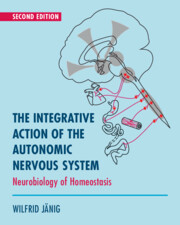Book contents
- The Integrative Action of the Autonomic Nervous System
- Reviews
- The Integrative Action of the Autonomic Nervous System
- Copyright page
- Dedication
- Contents
- Foreword to the Second Edition
- Foreword to the First Edition
- Preface
- Abbreviations
- Introduction The Autonomic Nervous System and the Regulation of Body Functions
- Part I The Autonomic Nervous System: Functional Anatomy and Interoceptive Afferents
- Part II Functional Organization of the Peripheral Autonomic Nervous System
- Chapter 3 The Final Autonomic Pathway and its Analysis
- Chapter 4 The Peripheral Sympathetic and Parasympathetic Pathways
- Chapter 5 The Enteric Nervous System
- Part III Transmission of Signals in the Peripheral Autonomic Nervous System
- Part IV Representation of the Autonomic Nervous System in the Spinal Cord and Lower Brain Stem
- Part V The Centers of Homeostasis in the Mesencephalon and Hypothalamus and Their Telencephalic Control
- Index
- References
Chapter 3 - The Final Autonomic Pathway and its Analysis
from Part II - Functional Organization of the Peripheral Autonomic Nervous System
Published online by Cambridge University Press: 16 July 2022
- The Integrative Action of the Autonomic Nervous System
- Reviews
- The Integrative Action of the Autonomic Nervous System
- Copyright page
- Dedication
- Contents
- Foreword to the Second Edition
- Foreword to the First Edition
- Preface
- Abbreviations
- Introduction The Autonomic Nervous System and the Regulation of Body Functions
- Part I The Autonomic Nervous System: Functional Anatomy and Interoceptive Afferents
- Part II Functional Organization of the Peripheral Autonomic Nervous System
- Chapter 3 The Final Autonomic Pathway and its Analysis
- Chapter 4 The Peripheral Sympathetic and Parasympathetic Pathways
- Chapter 5 The Enteric Nervous System
- Part III Transmission of Signals in the Peripheral Autonomic Nervous System
- Part IV Representation of the Autonomic Nervous System in the Spinal Cord and Lower Brain Stem
- Part V The Centers of Homeostasis in the Mesencephalon and Hypothalamus and Their Telencephalic Control
- Index
- References
Summary
The spinal cord and brain stem are connected to the autonomic target cells by two-neuron chains of the peripheral sympathetic and parasympathetic nervous systems. These chains consist of populations of preganglionic neurons and postganglionic neurons that are synaptically connected in the autonomic ganglia. They transmit messages from the central nervous system to the target cells are called "final autonomic pathways." These pathways are the building blocks of the peripheral autonomic nervous system. The main difference between the final somatomotor pathways and the final autonomic pathways is that the central messages may undergo quantitative changes in the autonomic ganglia, and that some effector cells are innervated by more than one type of functional autonomic pathway. The impulse pattern transmitted by peripheral autonomic pathways to the target cells is the result of integration in the spinal cord, brain stem, hypothalamus and telencephalon. Reflex patterns that are generated by afferent stimuli in peripheral autonomic neurons may serve as physiological markers to analyze the functional structure of the autonomic circuits in the neuraxis. Using this approach of neurophysiological recording from single autonomic neurons in vivo, detailed knowledge has accumulated about the organization of the autonomic nervous system in animals and humans.
Keywords
- Type
- Chapter
- Information
- The Integrative Action of the Autonomic Nervous SystemNeurobiology of Homeostasis, pp. 73 - 85Publisher: Cambridge University PressPrint publication year: 2022

